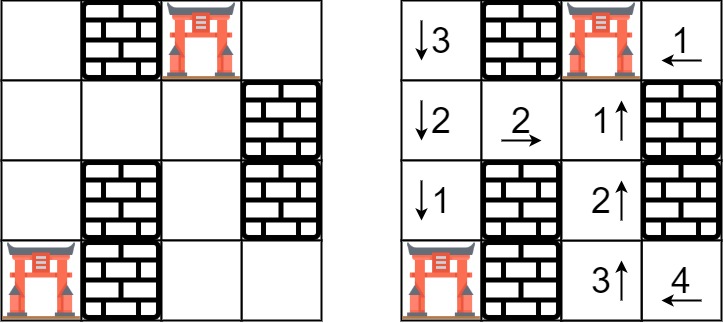You are given an m x n grid rooms initialized with these three possible values.
- -1 A wall or an obstacle.
- 0 A gate.
- INF Infinity means an empty room. We use the value 231 - 1 = 2147483647 to represent INF as you may assume that the distance to a gate is less than 2147483647.
Fill each empty room with the distance to its nearest gate. If it is impossible to reach a gate, it should be filled with INF.

Example 1:
Input: rooms = [[2147483647,-1,0,2147483647],[2147483647,2147483647,2147483647,-1],[2147483647,-1,2147483647,-1],[0,-1,2147483647,2147483647]]
Output: [[3,-1,0,1],[2,2,1,-1],[1,-1,2,-1],[0,-1,3,4]]
Example 2:
Input: rooms = [[-1]]
Output: [[-1]]
Example 3:
Input: rooms = [[2147483647]]
Output: [[2147483647]]
Example 4:
Input: rooms = [[0]]
Output: [[0]]
Constraints:
- m == rooms.length
- n == rooms[i].length
- 1 <= m, n <= 250
- rooms[i][j] is -1, 0, or 2^31 - 1.
Solution
class Solution {
int[] DIRS = new int[] {0, 1, 0, -1, 0};
public void wallsAndGates(int[][] rooms) {
int m = rooms.length;
int n = rooms[0].length;
Queue<int[]> q = new ArrayDeque<>();
for (int i = 0; i < m; i++) {
for (int j = 0; j < n; j++) {
if (rooms[i][j] == 0) {
q.add(new int[] {i, j});
}
}
}
while (q.size() > 0) {
int[] point = q.poll();
int row = point[0];
int col = point[1];
for (int i = 0; i < DIRS.length - 1; i++) {
int x = row + DIRS[i];
int y = col + DIRS[i + 1];
if (x < 0 || x >= m || y < 0 || y >= n || rooms[x][y] != Integer.MAX_VALUE) {
continue;
}
rooms[x][y] = rooms[row][col] + 1;
q.add(new int[] {x, y});
}
}
}
}